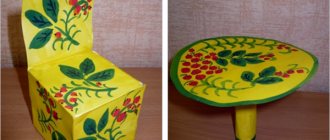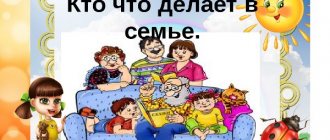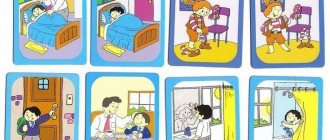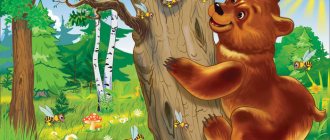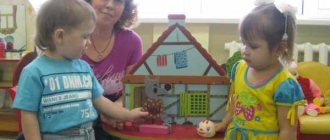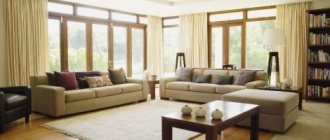"Furniture" GCD in the second junior group
Performed:
Ivanova Elena Yurievna,
teacher
MADOOU Borovsky kindergarten "Zhuravushka"
GCD summary: “Development of mathematical abilities by means of non-traditional drawing in the second junior group on the topic “Furniture”
Goal: To develop children's powers of observation, elementary mathematical concepts, and holistic visual perception of the world around them.
Tasks:
1. Develop the ability to navigate in spatial directions (draw lines from top to bottom, left to right, use the words “on”, “in”, “behind”);
2. Develop the ability to see the general characteristics of objects (shape, color, size, material of manufacture), use the general concept of “furniture”;
3. Continue learning to draw straight lines.
GCD move:
During free play activities, children find a broken doll chair and table.
Children: - Elena Yuryevna!
Educator: - What happened, guys?
Children: - The furniture for the dolls is broken!
Educator: - What a pity... But we can help the dolls! And I know how! Where do you think furniture is made?
— Children's answers (at the factory)
Educator: - Correct!
Educator: - Guys, let's help our toys. I propose to open a furniture factory here. Close your eyes, turn around yourself - one, two, three! We became carpenters!
What pieces of furniture do you know? (children's answers). Bed, chair, table, wardrobe.
What do they sleep on? (on the bed).
Where do clothes go? (into the cupboard).
What are they sitting on? (on the chair)
What do they have lunch for? (At the table)
What is furniture made of? (from boards).
On the table for each child are prepared sheets of dots, as well as gouache and cotton swabs.
In front of the children there is a children's table and chair
Educator: What is there at the table?
Children: Legs and table top. They show.
Educator: What does the chair have?
Children: Seat, back and legs?
Educator: What do a table and a chair have in common?
Children: There are 4 legs, the seat and table top are square, and the table and chair are made of wood.
Educator: To make furniture, you need special drawings, which are called “schemes”. Can you draw? (yes) Then let's try to draw diagrams of a table and a chair...
Before us lie really smooth boards and drawings - mysterious drawings.
Educator: If you look at them carefully, you will see what it looks like: a table or a chair. what should be done?
The dots will help you read the drawing, open the drawing. Try to connect these points with a line (I show you how to do this on the sheet). The guys begin to draw and connect the lines of their drawings.
At the end of the GCD we consider what tables and chairs we got.
Cheerful music plays, the teacher and the children conduct the dance game “We are sitting on chairs.”
Educator: - What wonderful masters you are! Now we can send these drawings of chairs and tables to a furniture factory. And they will make us new furniture for the dolls! And then they will deliver it for our dolls! (put the drawings in a large envelope to send them)
Used Books
- From birth to school. Basic educational program of preschool education / ed. NOT. Veraksy, T.S. Komarova, M.A. Vasilyeva. – 4th ed., revised. – M.: MOSAIKA-SYNTHESIS, 2022. – 352 pp.;
- Approximate comprehensive thematic planning for the program “From birth to school.” Second junior group / Ed. T.S. Komarova. - .: MOSAIC-SYNTHESIS, 2022. – 168 pp.;
- Complex classes according to the program “From birth to school” edited by M.A. Vasilyeva, V.V. Gerbova, T.S. Komarova. Second junior group / author-comp. T.V. Kovrigina, M.V. Kosyanenko, O.V. Pavlova. – Volgograd: Teacher, 2013. – 262 p.;
- https://www.maam.ru/detskijsad/konspekt-zanjatija-po-poznavatelnomu-razvitiyu-vo-vtoroi-mladshei-grupe-na-temu-mebel.html
“Certificate of publication in the media” Series A No. 0007630
We invite teachers of preschool education in the Tyumen region, Yamal-Nenets Autonomous Okrug and Khanty-Mansi Autonomous Okrug-Yugra to publish their teaching materials: - Pedagogical experience, original programs, teaching aids, presentations for classes, electronic games; — Personally developed notes and scenarios of educational activities, projects, master classes (including videos), forms of work with families and teachers.
Why is it profitable to publish with us?
1. “Kindergartens of the Tyumen Region” is an officially registered specialized media outlet at the federal level. 2. The activities of the editorial office are supported by the Department of Education and Science of the Tyumen Region 3. We issue a “Certificate of Publication” in the media. 4. The document has a unique number, is entered in the register, has the original seal of the editorial office of the online publication and signature. 5. “Certificate of publication” in the media is sent to the author in both paper and electronic versions.
Details >>>
Sample “Certificate of publication of author’s methodological material in the media.”pdf
Share
Kindergarten "Kalinka", Volgodonsk
Program content:
Educational: Teach children to answer questions. Consolidate generalizing words in children’s speech; encourage children to maintain dialogue; to form an idea on the topic: furniture, to cultivate interest in cognitive activity, to broaden one’s horizons.
Developmental tasks: Develop variable thinking, speech, memory, attention, imagination, ability to analyze.
Educational objectives: To cultivate interest in the activity, the desire and habit of thinking, the desire to learn something new, to cultivate friendly relationships with peers.
Vocabulary work: Enrich and activate children’s vocabulary on the topic “furniture”, add new words.
Class methods:
1. Gaming
2.Practical
3. Visual
4 Verbal
Integration of educational areas: Cognition, Socialization, Communication, Physical education.
Types of children's activities: Playful, communicative, educational and research.
Demonstration material: Pictures of furniture, children's furniture (toys), a small doll (doll), drawings.
Teacher I.V. Khishko
Progress of the lesson:
Educator:
Guys, listen to the simple story: Lena was looking for a pin, The pin fell under the bench.
Listen again (The teacher pronounces the words of pure speech slowly and clearly). Then the teacher asks questions: “What was the girl’s name?” (Children's answers) -What was the girl looking for? (Children's answers) -Where did the pin fall? (Children's answers) -What is a shop? (This is a long seat on wooden legs, without a back.) Look at the picture of the bench. -In ancient times, there were no chairs in houses. There were long benches near the table. The whole family sat down at the table. But then the benches became inconvenient, because they were inconvenient to carry. And the man came up with a stool (shows a picture of a stool). Now the stool could be placed anywhere. But this is not enough for a person. He needs not only to sit, but also to rest while sitting. And the man nailed the back to the stool, and he got a chair (shows a picture of a chair). That's how we got chairs, guys, and then all the furniture. (Then the teacher shows pictures of furniture.) Educator: Look, what is this? (table, chair, wardrobe, sofa) Who can tell me: table, chair, sofa, wardrobe - what can you call it in one word? (Furniture) What other furniture do you know? (chair, bed....) What is the name of the store where they buy furniture? (Furniture) I want to know from you: why do we need furniture? A chair to…..(sit) A table to….(Eat at the table if the table is a dining table; draw if the table is a desk) Sofa to….(lie down, sit, rest) Bed to….(sleep, rest) Wardrobe...(things hang and lie on shelves in the closet) How should we care for our furniture? (Children's answers: wipe with a dust cloth or remove dust with a vacuum cleaner). Let's arrange our furniture in the room. (Arrange the furniture) Well, everything is ready. Who will live in our apartment? Children, together with the teacher, look for a suitable object in the group (a small doll or any small toy) - We have worked hard, and now let’s rest a little. Physical exercise “Cleaning” (movements are performed that imitate cleaning): -Put on aprons; -Rolled up the sleeves; -Get ready, take some rags; -Wipe the dust from the closet (high, on toes); -Wipe the cabinet doors (from top to bottom); -We hang clothes in the closet; -Wipe the dust from the table; -We take out the vacuum cleaner; -Vacuum the carpet; -We are tired, we wipe our forehead; -Remove the apron, roll out the sleeves; - Let's clap for ourselves. Educator: Now let’s play the game: “Say a word.” Do you really want to sleep? Waiting for you in the bedroom...(bed) To rest your legs, sit - you on....(chair) Jam and I will drink tea at the dining room...(table) It will be nice for dear mother to relax on a soft...(sofa) Jacket, trousers, We’ll carefully fold the warm scarf... (in the closet) Guys, I’ve prepared pictures for you to take home, color them at home, and be sure to tell mom and dad what we talked about in class today. These pictures, what are they? Children: furniture. Educator: That's right, guys. Color it at home? Children: Yes Summary of the lesson. -Well, our lesson has come to an end. - Guys, what did we talk about today? -What did you like most?
Summary of the lesson “Let's arrange a room for a doll” in the first junior group of kindergarten
Summary of an open lesson on speech development in the first junior group (Agreement of nouns and pronouns with verbs) “Let's arrange a room for a doll”
Purpose: To train children in correctly naming pieces of furniture. Objectives: - Strengthen the skill of agreeing nouns with verbs and pronouns. — Develop the ability to answer the teacher’s questions in words or simple phrases, and form an active vocabulary. — To develop communication skills during gaming activities. Materials: Barbie doll Masha, table, chairs, bed, wardrobe.
Course of the lesson
Organizational moment Children sit in a semicircle, in the center of which is a children's table.
The teacher brings in the doll. - Children, let's introduce ourselves, this is the Masha doll.
- There will be a Machine room here (the teacher circles the surface of the table)
.
Masha will live here. - Masha, do you like your room? (children also address the doll with these words)
- No
(the doll answers)
I don’t like my room.
It's somehow empty. In my room there is no table, no chairs, no bed, no closet. “Children, how can we help Masha?” Where can we get a table, chairs, and a bed for Masha’s doll? We will buy them in a store called “Furniture”. I’ll call the store now and ask them to bring furniture for Masha’s doll. (The teacher calls and lists the pieces of furniture that need to be brought)
.
Hear, the car is already driving, buzzing. How does the car sound? Come into our yard and quickly unload the furniture. We call furniture together, we know exactly what to do with it! The teacher takes furniture out of the body. Fixing the names of pieces of furniture and their purposes. - What is this? (the teacher sets up the table)
- What is the table for?
Children's answers. (Masha will eat, draw, etc.)
- What else did Masha ask to put in the room?
— What should be put on the table? - Children's answers (chairs, chair)
Of course
(puts a chair)
- What is a chair for?
Children's answers (Sit)
- And to make the room cozy, we'll add more furniture.
- What is this? (the teacher sets up a wardrobe)
- What is a wardrobe for?
(Hang clothes. For linen.) (The teacher puts clothes in the closet)
- what else is missing in Mashenka’s room?
-Where does everyone like to sleep? (children's answers bed)
- Let's put Mashenka to bed?!
(children's answers yes)
- and what will Masha sleep dressed?
(no children)
- what needs to be done?
(children: undress, take off clothes)
- And where should you hang the clothes
(in the closet)
Mashenka lie down and rest
Teacher: while Mashenka is resting, let’s also warm up a little? Physical education lesson There is a lot of furniture in the apartment. One, two, three, four, - (clap their hands)
There is a lot of furniture in the apartment.
- (jump on the spot)
We’ll hang a shirt in the closet, -
(make turns left and right)
And we’ll put a cup in the cupboard.
- (raise their arms up and stretch)
So that the legs can rest, -
(shakes each leg)
Let's sit on the chair for a little while.
- (squat down) Educator: guys, it’s time for us to wake up Mashenka “I have bells (shows)
, with their help we will wake up the doll.
Listen to the sound of the little bell: ding-ding-ding. Repeat. (Children pronounce the sound combination in chorus and one at a time.)
And the larger bell rings like this: don-don-don.
How does it ring? And Mashenka woke up. - Did you get enough sleep? The doll answers yes! And asks the children questions: - When you come home, where will you sleep on the table? (the answers are not on the bed)
Will you probably draw in the closet?
(no, we’ll draw on the table) The doll Masha praises the children and invites them to take a closer look at the furniture in her room.
We recommend watching:
Summary of educational activities for speech development in the 2nd junior group. Forest walk Summary of a lesson on speech development in the younger group Lesson on speech development and drawing for children of the younger group Summary of educational activities for speech development using a regional component for the younger group
Similar articles:
Lesson notes on speech development in the second junior group
